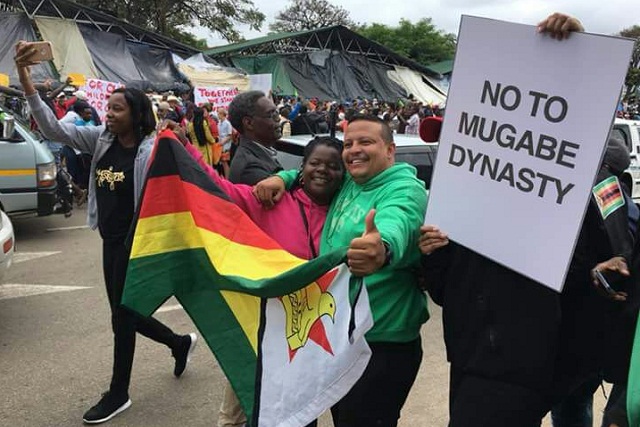
Harare, Zimbabwe | AFP | Zimbabwe is locked in one of its worst political crises since independence with strongman Robert Mugabe refusing to resign despite a military takeover, mass street protests and possible impeachment.
Here is a snapshot of the ongoing turmoil:
– Vice president sacked –
November 6: Mugabe fires Vice President Emmerson Mnangagwa to resolve a succession dispute.
His removal appears to clear the way for Mugabe’s wife Grace, 52, to take over as president — a move that angers the military, which has close ties to Mnangagwa.
– Army takeover –
November 14: In the evening, tanks move towards Harare, with gunfire heard around Mugabe’s residence a day after a blunt warning from army chief General Constantino Chiwenga.
By the early hours, military’s vehicles are on the capital’s streets, but deny staging a coup, giving a televised address saying the 93-year-old leader is safe and that they are “only targeting criminals around him”.
November 15: South Africa says Mugabe has told its president, Jacob Zuma, by telephone that he is under house arrest but is “fine”.
The European Union and former colonial power Britain urge a peaceful resolution of the crisis while South Africa warns against any “unconstitutional changes” of government.
– Mugabe digs heels in –
November 16: Mugabe refuses to step down during talks with generals, a source close to the army leadership says, in a move which enrages many Zimbabweans who see it as a bid to “buy time” to negotiate a favourable end to his 37-year reign.
A day later he appears at a university graduation ceremony, acting as if nothing has happened.
Meanwhile, opposition is gathering pace within his own ranks, with eight out of the 10 branches of Mugabe’s ruling ZANU-PF taking to state television to demand he stand down.
Zimbabwe’s influential war veterans association also demands he step down immediately, urging people to join huge street protests planned for the weekend.
– Mass protests –
November 18: Tens of thousands of people joyfully take to the streets across the country to demand Mugabe’s departure and celebrate his apparently imminent demise in scenes of public euphoria not seen since independence in 1980.
It is a display of open defiance that would have been unthinkable just a week earlier.
– Ousted as party chief –
November 19: ZANU-PF sacks Mugabe as leader and demands he resign as head of state. It also expels his wife Grace and names ousted VP Mnangagwa as the new party chief.
Adding to its stunning reversal of allegiances, it threatens to impeach Mugabe if he does not resign by Monday midday.
Mugabe meets with the army chiefs before making a defiant televised address in which he shows no sign of leaving, frustrating widespread hopes he would resign.
– Impeachment and protests –
November 21: After the ZANU-PF deadline passes without Mugabe resigning, the party says it will start impeachment proceedings on Tuesday.
Adding to the pressure from parliament, Mgangagwa issues a statement saying citizens had an “insatiable desire” for Mugabe to go, and the influential war veterans call for immediate protests.
These demands for a quick exit contrast with the longer approach required by impeachment.
Any move to impeach Mugabe would require a two-thirds majority in both houses of parliament, after a report is drawn up by an investigative committee.
And if he were impeached, it would mean the current vice president — Phelekezela Mphoko, who is loyal to Mugabe’s wife — would automatically be named as interim leader in a development the army would want to avoid.
 The Independent Uganda: You get the Truth we Pay the Price
The Independent Uganda: You get the Truth we Pay the Price




He is a hero and he has to resign peacefully.